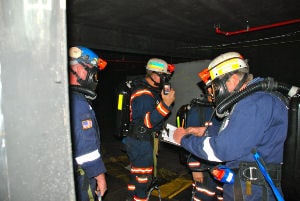Mining Topic: Rescue Technologies and Training
What is the health and safety problem?
When the lives of mine workers are in danger, mine emergency response systems must function rapidly and competently. The hierarchy of response actions begins with self-escape, then first responders and/or fire brigades, and last of all mine rescue teams. If there is a breakdown in self-escape and initial responders are not successful, then the deployment of mine rescue teams is necessary.
Just as in firefighting, team members accept some personal risk to save the lives of others. Hence, it is essential that the United States mine rescue teams are fully equipped with state-of-the-art technology, achieve competence with professional trainers, and receive guidance from the best available mine emergency response experts.
What is the extent of the problem?
Approximately 570 underground coal mines and 249 underground metal/nonmetal and stone mines operate in the United States. A recent survey conducted by the Mine Safety and Health Administration (MSHA) indicated that there are 364 state and company mine rescue teams in the U.S. with about 2,900 rescue team members.
Overall, the majority of activated mine rescue teams have performed well during mine emergency responses. However, the National Institute for Occupational Safety and Health’s (NIOSH) Mining Program has found that mine rescue teams possess highly variable levels of readiness, and some do not have the resources to be fully prepared for all types of mine emergency responses.
How is the NIOSH Mining Program addressing this problem?

Rescue team underground
In cooperation with state mining agencies and mining companies, more than 50 different mine rescue teams have evaluated a variety of rescue technologies during realistic training exercises conducted and evaluated at NIOSH’s research mines and other supporting mine rescue training centers. These training simulations require teams to make strategic decisions while they explore smoke-filled entries, rescue injured miners, navigate around obstacles such as bad roof and water, conduct equipment checks, and re-establish ventilation controls.
Technologies have been developed such as directional lifelines, lighted team link-lines, lifeline pulleys, various communication systems for team/fresh air base communication, thermal imaging cameras, retractors, foldable stretchers, high-intensity LED lights and strobes, chemical light sticks, and handheld lasers. Some of these technologies, such as lifeline pulleys and chemical light sticks, have already been adopted by many rescue teams. In addition, several strobe lighting technologies and lasers are now approved by MSHA as intrinsically safe and may be used in mine rescue applications.
What are the significant findings?
NIOSH research has identified numerous associated issues including the opportunity for realistic training, current skills training practices, standardization of skills and equipment, competency assessment, incident command, mine rescue contests, and coal mine rescue training facilities. NIOSH researchers also conducted an inventory of the United States and international coal mine rescue training practices, contest procedures, new technologies, and training facilities to take a closer look at the current skills disparity. The purpose of this research was to identify practices in the United States and around the world that could improve the current underground coal mine rescue system. Preliminary findings have identified that realistic skills training for the following basic competencies should be provided to all U.S. mine rescue team members.
Primary skills:
- basic mine rescue skills and practices (contest and real-life rules, first aid, map reading, mine gases, dust and ventilation, communications, breathing apparatus, rescue and fire fighting equipment, gas sampling, ventilation control construction, etc.);
- basic mining skills and knowledge (roof and rib control, shoring and cribbing standing support, sources of ignition, the importance of adequate rock dusting, equipment safety, electrical dos and don'ts, etc.);
- advanced first aid and life support systems (e.g., a paramedic on each team);
- specialized fire fighting;
- ventilation effects of fires;
- gas analysis, sampling, and trend analysis;
- navigation and working under apparatus and in reduced visibility (smoke or dust);
- multiple team rotation procedures;
- incident-command training;
- problem-solving and decision-making.
Non-typical skills:
- heavy-object lifting or removal;
- vertical-rope rescue or repelling from structures or shafts and raises;
- still and swift water rescue.
What are the next steps?
Efforts are underway to offer further guidance to mine rescue teams to provide practical and realistic training that will increase readiness and better equip mine rescue teams for any kind of mine emergency response. The completed inventory of coal mine rescue training capabilities and facilities across the United States and in several other countries could include a similar investigation of training practices for underground metal/nonmetal mines. NIOSH plans to incorporate mine rescue and incident command modules into the Mine Rescue and Escape Training Laboratory. This laboratory is developing innovative training methods based on virtual reality technologies for use in mine safety and health training classes.
- Development of a Gas Monitor Simulator and Mine Rescue Contest Field Trials
- Emerging Technologies: Aiding Responders in Mine Emergencies and During the Escape From Smoke-Filled Passageways
- Fire Response Preparedness for Underground Mines
- A Global Inventory of Mine Rescue Training Facilities: Compendium of Ideas to Improve U.S. Coal Mine Rescue Training
- In-Mine Study of High-Expansion Firefighting Foam
- Knowledge Management and Transfer for Mine Emergency Response
- Mine Rescue and Response
- Mine Rescue Training Facility Inventory - Compendium of Ideas to Improve US Coal Mine Rescue Training
- Mine Rescue Training Simulations and Technology
- New Vest Style Escape SCSR Through SCSR Efficiency Improvement Study
- An Oral History Analysis of Mine Emergency Response
- Rapid Rescue Drilling Equipment Transferred to National Mine Health and Safety Academy
- Rapid Response Rescue Drilling System Development for Mine Rescue Application
- Refuge Alternatives in Underground Coal Mines
- Refuge Chamber Deployment and Occupancy Status During Mine Emergency Situations
- Responders to Underground Mine Fires
- Seismic Detection of Trapped Miners Using In-Mine Geophones
- Sprinkler Head Emergency Communications
- System Reliability and Environmental Survivability